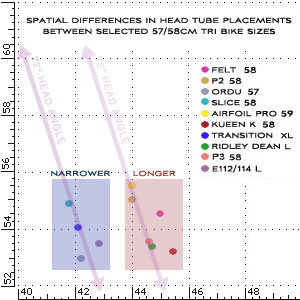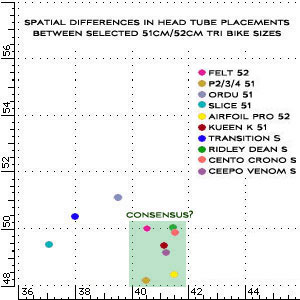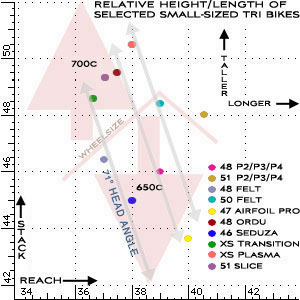58cm sizing comparison

When you get to the 58cm size or thereabouts, tri bikes diverge geometrically. Why? Because they can. At 52cm, they're pretty hemmed in. There isn't anywhere to go in terms of geometry. Head tubes, wheel size, shoe overlap, largely dictate the geometry.
But at 58cm, the world is a bike designer's oyster.
The height of these bikes is pretty similar, one to the next. They all pretty much coalesce around 54cm of stack. No less than 53cm, and only one bike more than 55cm.
But in reach, there's more of a divergence. You've got your longer bikes, and these average about 44.3cm in reach. Then you've got your narrower models, and these are on average about 2cm shorter (narrower).
So, while just about all the bikes diverge in height by only about 2cm, highest to lowest, in length the divergence is about 4cm, longest to shortest.
In the narrow column are the C'dale Slice, Orbea's Ordu, the Argon 18 E112/E114, and, The Specialized Transition.
Longer bikes are more prevalent, and they include: Cervelo's P2 and P3/4 (note the P2 is a taller bike, because of its taller head tube, than the P3/4); Felt's bikes, the Ridley Dean, and the Airfoil Pro by Kestrel.
Let's look at these head angles, and see if we can take a lesson. Consider what you've seen of the new "superbikes": bikes like the Giant Trinity Alliance, Specialized Shiv, Scott Plasma 3. These all have "disappearing stems."
You should be able to divine a truth from this. Aerodynamically, it appears beneficial to have the gap between the head tube and the aerobars diminished to largely zero. So…
What you see with Cervelo are two bikes with precisely the same geometry, except, the head tube extends higher on the P2 compared to the head tube top on the P3. Accordingly, if you were to ride the P3 in size 58 with 3cm of spacers under the stem, you'd ride the P2 with 1cm under the stem. Even though the P3 is, on paper, the fastest of the two frames aerodynamically, it's really a question whether the P3 would beat the P2 in drag if the P3 were stacked up to match the fit coordinates of a rider whose better natural fit is a P2.
What this means is, all things equal, the P3, or the Ridley Dean, are great bikes if you need that geometry (and many do—that is my own best geometry). But if you need a taller front end, the P2, or maybe the Airfoil Pro, might be a better geometry (just in terms of fit—remember that the Kestrel Airfoil Pro is a very quick handler in this size relative to the P2, so, the divergence between the P2 and the Airfoil Pro in this size is handling, not fit.
You could say the same about the Transition and the Slice. They each rest on the same head tube bias. But nobody should not make too much of this. The difference between the Slice and the Transition in height is only 1cm (as this 58cm bike size). So, if you take a Transition and add a single 10mm spacer, you've normalized the bike to fit exactly as does a Cannondale Slice.
And if you take this bike and add 2cm of stem length, you basically get a P2, that is, you've normalized for the difference in length.
If you're following such things, I'm riding a Cannondale Slice in the Tour of California Time Trial. Hearken back to my description of what I'll have to do to "normalize" my Slice to fit like me P3. Remember that I've got a 3T Ventus bar on my P3, with a built-in 9cm stem. I'll ride an 11cm stem on the Slice to normalize for the length difference between the two frames, and, I'll ride the Slice with a slightly flatter stem and a lower-profile headset top cap to normalize for the difference in height between the P3 and the Slice.
I think if you look at this chart, you can see how all this is fairly easy to figure.



